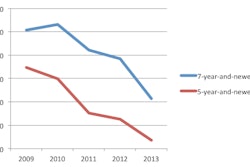 There are likely more than a few JCB 8026 CTS models of excavator beneath the streets of west London.
There are likely more than a few JCB 8026 CTS models of excavator beneath the streets of west London.Typically, excavators are the ones doing the digging; doing the uncovering and the filling. But deep below the streets of west London, thousands of excavators have met a cruel fate. One in which they have dug their own graves.
According to a report from the New Statesman, a trend began in the late 1990s among the wealthy in west London to start adding on to their homes. Problem was, there is no room in the city to build outward and London has very strict building codes that prohibit these residents from building upward in order to preserve the city’s architectural integrity.
Undeterred, these residents decided to build downward, spawning a booming business for “basement-conversion specialists.” According to a 2012 article from The Guardian, the London neighborhood of Kensington saw more than 800 applications for basement extensions. These contractors send two excavators (likely compact excavators) into the homes—either through one of the homes’ huge windows or by knocking a hole in the wall—which then begin digging a basement beneath the standing home.
The excavators sometimes dig as deep as 75 feet, adding enough square footage to triple the size of some of London’s finest homes. That allows these billionaires to build swimming pools, home theaters, garages, you name it.
But once the excavators are finished digging, the contractors have said there is no way to bring them back out. Since there’s a house on top of the hole they’ve just dug, a crane can’t be brought in to pull them out. The article doesn’t address the possibility of dismantling the machines and hauling them out piece by piece, but it sounds like these contractors don’t feel the effort of doing that would be worth it. The New Statesman article pegs the price of the machines between $8,400 and $10,000—not enough to justify the cost of removal. The cost of leaving the machines where they lie is worth being able to move on to the next job.
To entomb the machines, a layer of sand and gravel is poured on top of them and their fate is sealed with a layer of concrete. Estimates say up to 1,000 of the machines have been buried beneath the city.
But not everyone in London is pleased with these wealthy homeowners’ method of getting around building codes. As the Guardian article points out, neighbors of these homes and city officials have voiced their displeasure with the noise and disruption the ongoing construction has brought into the city. And more importantly, they worry that because the buildings around these homes don’t have the added benefit of a basement further stabilizing them, they might suffer structural damage because of the excavation.
In fact, that exact thing happened in the summer of 2012 when a home undergoing a basement extension began sinking, bringing its neighbors with it.












